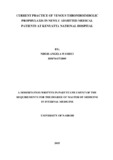| dc.contributor.author | Nderi, Angela W | |
| dc.date.accessioned | 2015-12-17T06:27:11Z | |
| dc.date.available | 2015-12-17T06:27:11Z | |
| dc.date.issued | 2015 | |
| dc.identifier.uri | http://hdl.handle.net/11295/93703 | |
| dc.description.abstract | BACKGROUND
Venous thromboembolism (VTE) prophylaxis has been shown to be safe and effective.
Underutilization of this intervention results in avoidable morbidity, readmissions, and
mortality. The underutilization of VTE prophylaxis occurs despite there being evidencebased
guidelines on VTE prophylaxis from various medical societies. Information on the
prevalence of risk in the acute medical hospital care setting is scarce. The evaluation of VTE
prophylaxis administration will aid in identifying possible gaps in administration of this life
saving measure.
OBJECTIVE OF THE STUDY
The objective of this study was to determine the level of risk for VTE and prescription of
thromboprophylaxis in medical in-patients and assess the knowledge and practice of senior
house officers’ (SHO) in the Department of Clinical Medicine and Therapeutics at Kenyatta
National Hospital in regard to VTE prophylaxis.
STUDY DESIGN
Cross sectional descriptive study
PARTICIPANTS AND STUDY SITE
Eligible newly admitted medical in-patients on their third post admission day at Kenyatta
National Hospital, a tertiary referral hospital, and SHOs in the Department of Clinical
Medicine and Therapeutics in the University of Nairobi.
METHODS
Four hundred eligible study patients were selected using a random number generator. They
were scored using the Padua Prediction Score and classified as low or high risk. Their
medical files were reviewed for thromboprophylaxis prescription. Consenting senior house
officers in the Department of Clinical Medicine and Therapeutics in the University of
Nairobi training at the Kenyatta National Hospital were invited to fill a validated
questionnaire on VTE prophylaxis.
DATA MANAGEMENT
The data was analyzed using SPSS version 21.0. Descriptive statistics were used to present
the results.
RESULTS
Two hundred and sixty eight (67%) out of 400 were found to be in the high-risk category of
VTE. Ninety-eight (36.6%) out of 268 had no prescription of VTE prophylaxis. Seventyeight
(19.5%) out of 400 had increased risk for bleeding. Most [164 (71.9%)] were offered
unfractionated heparin while 64 (28.1%) were offered enoxaparin with correct prescription
in 54 of those patients. Eleven (16.9%) of the residents were unaware of the ACCP 2012
guidelines for VTE prophylaxis. Sixty percent had either never had formal updates or had
updates more than a year ago while eleven (16.9%) had not undertaken self-directed
updates. In addition, while most (83.2%) felt that a patient who is entitled to VTE
prophylaxis should receive it, 81.5%felt that VTE risk assessment was not incorporated into
the work flow and 92.3% felt that they were left to make the decision on their own. The
preferred agent for VTE prophylaxis was LMWH by 89.2%. This was however not observed
in their prescriptions.
CONCLUSION
A majority of medical patients were at high risk for VTE with only slightly more than half
receiving the appropriate action. The residents faced challenges in VTE prophylaxis
prescription such as the lack of both VTE risk assessment models, guideline implementation
into the workflow of patient care and updates on the existing international guidelines.
Key words: Venous thromboembolism, acutely ill medical patients, thromboprophylaxis | en_US |
| dc.language.iso | en | en_US |
| dc.publisher | University of Nairobi | en_US |
| dc.title | Current practice of venous thromboembolic prophylaxis in newly admitted medical Patients at Kenyatta National Hospital | en_US |
| dc.type | Thesis | en_US |
| dc.description.department | a
Department of Psychiatry, University of Nairobi, ; bDepartment of Mental Health, School of Medicine,
Moi University, Eldoret, Kenya | |

